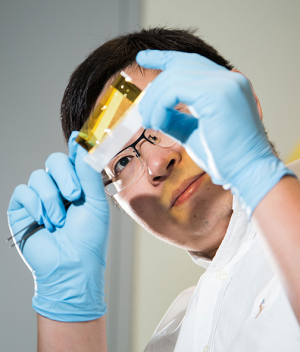Cunjiang Yu, assistant professor of mechanical engineering at the UH Cullen College of Engineering, earned a $500,000, five-year CAREER award from the National Science Foundation (NSF) to continue development of his novel manufacturing process for three-dimensional (3D) curvilinear electronics.
While microfabrication with planar and rigid silicon wafers has been used in conventional two-dimensional (2D) electronics for more than a few decades, manufacturing processes for electronics in 3D curvilinear constructs have not yet been developed. With this NSF CAREER award, Yu will explore a platform for conformal stamp printing and manufacturing technology to provide a practical process for construction of 3D electronics.
Using a deformable inflated elastomer balloon with a sticky surface, Yu grabs the ink from a conventional planar surface and presses the balloon to a curved or uneven 3D surface until it conforms, thereby printing the ink. The ink endures a safe level mechanical strain during the process and the speed of retracting the balloon determines whether the ink is grabbed or printed.
Yu’s five-year project will explore the manufacturing process, study the interfaces between the stamp and the inks, and investigate the deformation mechanics and the pattern distortion of the inks during grabbing and printing.
The award will also support educational and outreach activities, and Yu intends to pursue a variety of avenues. He plans to develop a “3D Curvilinear Electronics Day” workshop for junior high and high school teachers and their students, especially those from underrepresented groups; to promote both undergraduate and graduate research; to develop new courses for engineering students; to incorporate research outcomes into the upcoming manufacturing graduate program at UH; and to disseminate knowledge to the general public.
“A piece of paper cannot conform when wrapped around a sphere, and during manufacturing, the devices need to be geometrically compatible,” Yu said. “The elastomer balloon is capable of conformation to most surfaces – flat, curved and uneven – so the pre-fabricated electronics as inks on the balloon need to survive stretching or certain amounts of strain during the lifting and printing steps.”
The findings from Yu’s research project will remove a major roadblock to 3D curvilinear electronics manufacturing. Potential applications for Yu’s novel process include telecommunication, biomedical, solar and camera technologies, among others.
